| 1 | A massively widespread snake |
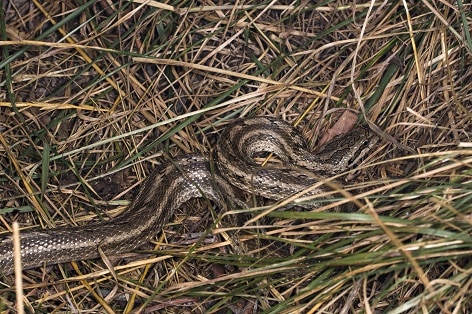
The steppe ratsnake is a member of the huge Elaphe snake genus, also containing the Japanese ratsnake and Italian four-lined snake. When it comes to length, diet, and personality, this species is pretty average. Where the steppe ratsnake stands out is in being one of the most widespread snakes in the world, with a colossal empire spanning thousands of miles.
To the west, steppe ratsnakes (Elaphe dione) just reach Europe’s eastern borders, with a sizeable colony in the southern Ukrainian countryside. They then begin a huge trek across the whole of Asia, stretching through Turkey, Azerbaijan, northern Iran, southern China, before finally ending up in South Korea.
This species is steppe by name and steppe by nature, as they love rugged open areas. They avoid dense forests, and only occasionally appear in open woodlands. Steppe ratsnakes mostly inhabit hilly or low mountainous areas, with a mixture of open plains and shrubland with knee high bushes. They rarely appear in the centre of dense crop fields, but are common around the uncultivated edges. They can appear at up to 2000 metres in central Asia, but usually stick to below 500 metres in eastern Europe.
Steppe ratsnakes can be found scaring Tibetan monks, Ukrainian sunflower farmers, and Iranian goat herders alike. They cover just as much territory as the boa constrictor, yet despite this, barely any Westerners have heard of them.
| 2 | Unusual eggs |
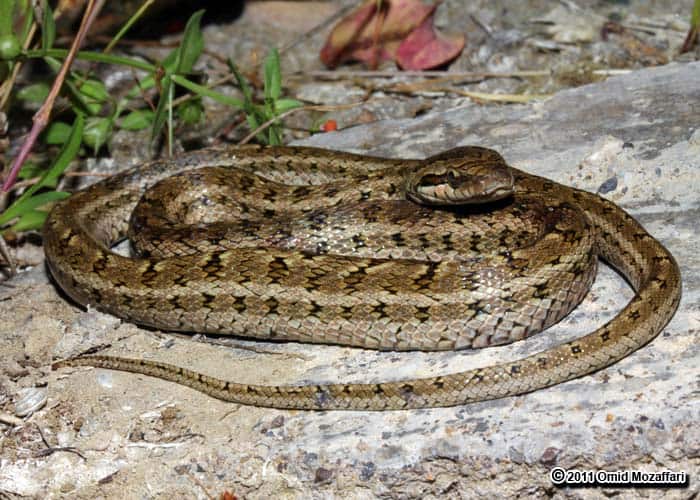
The steppe ratsnake’s most unusual feature is being a halfway house in laying young. Some snakes lay eggs while others produce live young in thin, clear sacs that allow them to instantly break free (ovoviviparous). Dione ratsnakes lay eggs, but unusually fragile ones, with the young inside already being partially formed. Keepers have testified that Dione ratsnakes can hatch in just 14, 10, or even 6 days after laying, one of the fastest on record. The eggs are also soft to touch, even pliable, rather than firm and hard.
It’s theorised that living in cold northerly climates such as Ukraine is responsible, as it made sense for eggs to develop further inside the mother’s warmish belly before being laid. The eggs are normally laid in totals of 3-24.
Being a northerly snake, Dione ratnakes have a natural dislike for warmer temperatures. According to keepers, they curl up and take shelter when the mercury hits just 27 degrees, going completely still as though knocked out. Wild steppe ratsnakes disappear during the hottest part of the day, being most active from 9-11:00 and then 14-16:00, in two separate sessions of ratsnake action.
| 3 | Master of disappearing |
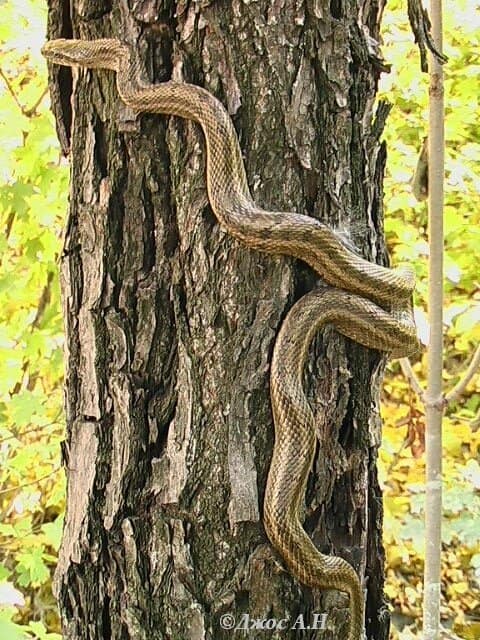
Steppe ratsnakes aren’t a massively adventurous snake, sticking to a medium size home area. Male steppe ratsnakes patrol a larger area than females, but this varies by snake – some are bold and advenerous, while others stick to a cosy corner.
Dione ratsnakes have a natural instinct for taking shelter. Whether it’s rock hollows, mammal burrows, or shadowy gaps in tree trunks, this snake has the eye for hideaways and will rapidly vanish into them if they sense the shadows of birds overhead. The bird will find no evidence that the snake was ever there, perhaps doubting its own recollections.
Dione ratsnakes often invade underground mammal galleries, eating the small, scurrying occupants. With no venom, they kill their prey via constriction. Dione ratsnakes have round pupils, and the irises can be grey or orange, but never red. Round pupils are the norm for day-faring snakes, with nocturnal species having freaky vertical slits.
| 4 | Comfortable around humans |
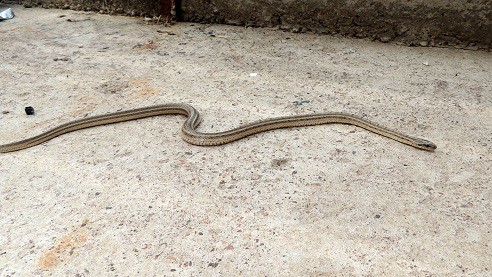
Dione ratsnakes are also extremely comfortable in manmade environments. In 2022, a study analysed two adjacent nature reserves in northeast China: Xianghai National Nature Reserve and Red-Crowned Crane Park. The former was untouched, while the second was a busy bird watching sight packed with chattering tourists. Surprisingly, Dione ratsnakes were more common in the latter area. The ratsnakes rested on walls, hid within gaps in brickwork and thrived in the landscape of paved paths and tourist hangouts.
The ratsnakes were never once spotted in open water. Sandy plains were an occasional hangout, while grassland (37.30%) and reedy wetlands (17.08%) were the most popular natural habitats. Manmade environments accounted for 42.04% of sightings, as recorded by camera traps hidden in the shadows. In this reserve, Dione ratsnakes shared its space with two serpent neighbours: the tiger keelback and slender racer (Orientocoluber spinalis).
Overall, steppe ratsnakes are one of the calmest ratsnake species. They’re naturally curious, and don’t seem bothered by the presence of humans at all. They rarely flee into the bushes in fright, and bites happen once in a blue moon.
| 5 | Calm and non-territorial |
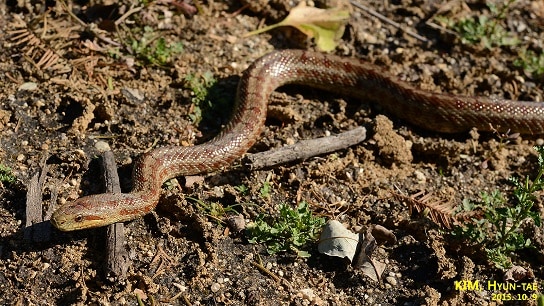
Dione ratsnakes lack any venom, not even a mildly toxic saliva used for subduing tiny mice. Dione ratsnakes do have a long tail, and would like you to believe that they have whipping skills. When threatened, they move the tail from side to side to give an impression of power and flexibility.
The study above also found that Dione ratsnakes were relaxed about overlapping with each other. They weren’t fiercely territorial, as males and females slithered close by to each other without sudden conflict breaking out. This fits in with the testimonials of calm personalities from keepers.
In fact, they happily share shelters with each other, accumulating in vast gatherings, making them one of the more social snake species. Dione ratsnakes were even observed sharing shelters with their venomous neighbour the tiger keelback, as well as slender racers. It’s theorised that they seek out these proven safe refuges using their sharp sense of smell.
| 6 | Diet: nearly all mammals |
Most ancient textbooks mention steppe ratsnakes eating mammals, and this was finally confirmed in 2022. 79 steppe ratsnakes were studied in the wilds of South Korea, with their stomach contents being analysed. Mammals made up their diet exclusively, with 5 species detected:
- House mouse (the ubiquitous mouse worldwide).
- Korean red-backed vole.
- Asian lesser white-toothed shrew.
- Korean field mouse.
- Brown rat (Rattus norvegicus).
Keepers unanimously agree that steppe ratsnakes are extremely easy to feed in captivity. Elaphe dione will happily gobble down any pinkie mice or rodents you fling at them, with no need for trickery like disguising them with scents. They’ll also swallow down bird eggs, being part of the same family as the notoriously egg-eating Japanese ratsnake.
Dione ratsnakes can eat large chunks per meal, but have natural limits on their hunger, making them very difficult to overfeed. They’re also preyed upon by snakes themselves, namely Caspian whipsnakes, a non-venomous yet viciously aggressive species. Scientists in Kalmykia province, southern Russia, saw one swallowing a 85cm Dione ratsnake at the edge of an irrigation canal. The spooked snake spotted the scientists, regurgitated its prey, and fled.
| 7 | Cobra-resistant |
Elaphe dione has no venom and little involvement in toxins whatsoever. Its ancestors swore off the dark arts of venom long ago, becoming a humble grabber instead, but a study found that they retain some ancestral resistance to snake toxins. It tested a neurotoxin extracted from Chinese cobra venom called cobrotoxin. This is a fairly typical post-synaptic neurotoxin, blocking acetylcholine receptors in muscle cells which receive brain signals (similarly to a black mamba). It’s responsible for the venom’s paralysis, lung failure and drooping eyelids.
When injected into Chinese cobras, they proved to be fully resistant to their own cobrotoxin. This sounds obvious, but isn’t a given – green catsnakes have died after being envenomated by their fellow kind. The scientists then turned their attention to non-venomous species. It found that Chinese garter snakes, twin-spotted ratsnakes and Dione ratsnakes were all equally immune to cobrotoxin from Chinese cobras.
The acetylcholine receptors were specially adapted, missing the usual sites for the neurotoxins to bind to, much like the notoriously resistant mongoose of Africa. The Chinese cobra derives a chunk of its calories from snakes, so Dione ratsnakes may be part of a crew that are harder for them to hunt.
| 8 | Varies in appearance |
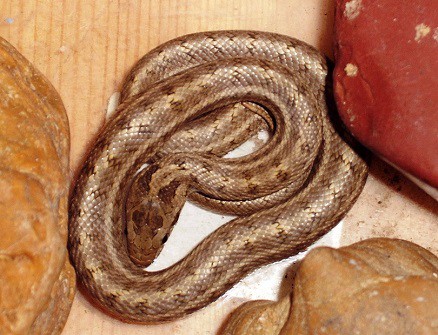
Dione ratsnakes have only very subtle patterns. The base of their scales is brown, while they have 5 fainter lines, one heading straight down the spine, and another two on each side. Between these stripes lie small black bars, with dozens of bars in total. However, these colours are sometimes barely separable from each other, blurring together. In other regions, Dione ratsnakes are brighter like a corn snake, with almost red tinges to the blotches and yellow beneath.
The weird thing is that despite such a massive empire, the Dione ratsnake has no confirmed subspecies. There was originally a black subspecies called Elaphe dione niger, identified in 1923, but this became void after black snakes were found popping up occasionally in virtually all locations.
Steppe ratsnakes also vary naturally in size. They average at 60-70cm long, but in northeastern China then can balloon to 160cm. It’s almost certain that subspecies will be identified eventually, and this monster version is a strong candidate. This northeast China version is also more aggressive, according to this keeper.
| 9 | Vulnerable to speeding traffic |
Steppe ratsnakes are a common snake in certain spots. A five year survey in Woraksan National Park of Korea, from 2005-2009, found that they were the second most abundant snake after the Ussuri pitviper.
Elaphe dione shares South Korea with another ratsnake, Oocatochus rufodorsatus, but this is a water-lover which feasts on frogs, while the steppe ratsnake stays far from lakes and ponds. The two are neatly divided.
The study also found that climate change could be benefitting the species. Hibernation can be a harsh time for northerly dwelling snakes, freezing them solid if they fail to find secure dens. The number of steppe ratsnakes in Woraksan National Park had a close positive correlation to temperatures the previous winter. But another manmade influence is slowly killing them: speeding cars. A survey from various South Korean national parks found that Dione ratsnakes were the second most common roadkill serpent after Ussuri pitvipers. Their attraction to human structures apparently extends to roads, but they lack the speed to jump out of the way.
| 10 | Lookalike: the twin-spotted ratsnake |
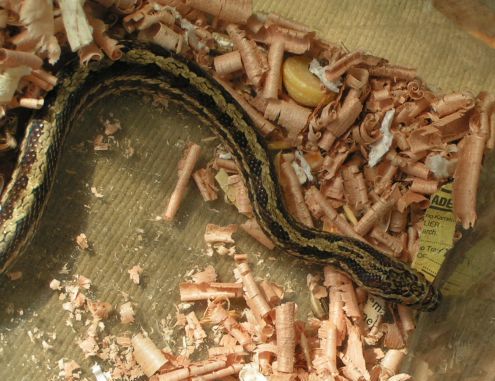
The closest relative of the steppe ratsnake is Elaphe bimaculata, AKA the twin-spotted ratsnake. This species lives further east, sticking to southeast China. The two look very similar at first glance, with some reptile enthusiasts purchasing Elapahe bimaculata by accident. However, with a few expert tips, you can learn to distinguish the two with ease.
Twin-spotted ratsnakes have a longer, narrower head than the Dione ratsnake. The black blotches are larger and more circular, whereas with Dione ratsnakes, they can be so tiny that they resemble minuscule Vs or pen squiggles. Both species have a black marking on the top of the head, visible from a bird’s eye view. However, the Dione ratsnake’s is U or W-shaped, versus V-shaped for twin-spotted ratsnake.
The scales around the lower jaw (infrablial scales) are what professional herpetologists use. Dione ratsnakes have 10-12, while their twin-spotted cousin has 8-10. The eggs are the final difference. Both are snowy white, but twin-spotted ratsnakes have longer, thinner eggs than the Dione ratsnake.
